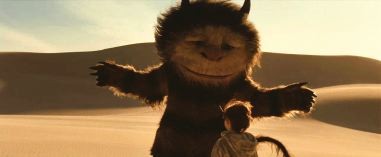Where the Wild Things Are

Spike Jonze’s film of Maurice Sendak’s classic children’s book, Where the Wild Things Are, substitutes pop psychology for Sendak’s exuberant, anarchic vision of childhood. Sendak’s hero is a boy named Max who’s sent to bed when his high spirits turn the corner into aggressiveness. He finds his room transformed into a jungle inhabited by savage creatures who make him their king. Max plays with them until his wild side is spent and then returns to his warm bed and a hot supper.
Children and parents love this meta phor for the childish id, which can play itself out in an imaginative realm while Max remains in the safety of his home. The Brothers Grimm painted a variety of monsters to represent the cruelty of the world that children have to learn to confront. Sendak, for his part, pioneered the idea that monsters could stand in for the uncivilized impulses of children themselves.
It’s hard to figure how Jonze and co-writer Dave Eggers arrived at their version. The movie provides Max (Max Records) with psychological reasons for his bad behavior, as if it were necessary to analyze every tantrum: his sister’s friends are mean to him, and his mother (Catherine Keener) has invited her new boyfriend (Mark Ruffalo) to dinner.
When his mother loses her temper with him, Max runs away. He takes a boat to an island where he infiltrates a community of wild animals, cunningly created by costume designer Casey Storm and make-up supervisor Katherine Brown to replicate Sendak’s beloved creations. James Gandolfini’s voice is immediately recognizable as Carol, who becomes attached to Max and convinces the others to adopt him as their monarch. Other well-known voice actors include Cath erine O’Hara, Paul Dano, and Lauren Ambrose as K.W., Carol’s sometime girlfriend.
The creatures veer between binges of destructive behavior and an unarticulated anomie that particularly besets Carol and K.W. Jonze and Eggers impose a manic-depressive view of childhood onto the story, yet they’re committed to keeping the wild things as expressively limited as a little boy—so the dialogue wrangles with their emotions in the form of stultifying clichés. The creatures stand in not so much for Max’s own unresolved feelings as for how children might see the world if their experience were filtered through the psychological platitudes of adults.
Charles Schultz tried something like this in Peanuts, but there the notion of kids who see the world through a neurotically grownup lens was a joke. Jonze and Eggers want us to take it seriously—to believe that children not only bring all this psychological baggage to their everyday lives but do so consciously. If these filmmakers were to rewrite Lucy’s “The Doctor Is In” sessions with Charlie Brown, they’d have her handing out somber nuggets of advice reflecting her awareness of how difficult life is.
Jonze wastes his talented cast, encouraging them to improvise but failing to give them anything to improvise on. Records isn’t an interesting enough actor to hold the camera’s focus for scene after scene. The movie is a drag, relieved only briefly by the spark of comedy provided by a pair of owls K.W. has adopted as her latest friends. She pretends to understand their jabber, and the others, fearful of appearing ignorant, go along with her.
The rest of the time we’re stuck listening to the simplistic babble of the wild things. When they’re not engaged in the activities Max initiates (a dirt war, building a castle), they sound like dispirited slackers coming down from an excess of partying and forced to ponder their disappointing lives. When Max admits to Carol that he isn’t a king, his friend demands, “Well, what are you?”
“I’m Max,” the boy replies.
Carol comments, “That’s not much of anything, is it?”
Why would Jonze and Eggers ever have thought this movie was suitable for children? It makes you want to go home and sleep it off.





